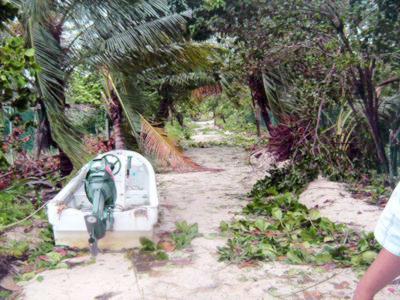 |
Dean’s mark on San Pedro can be noted as mostly windswept trees, broken piers and palapas, and debris on the streets, which the Mayor has vowed to have cleared as soon as possible.
|
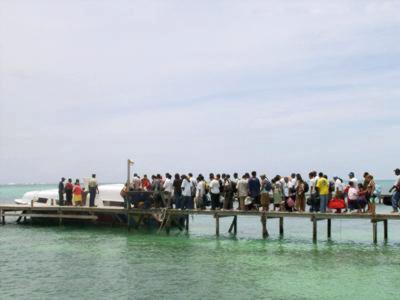 |
Reports estimate that over 9,000 residents fled the island to the mainland for cover from the potentially catastrophic Hurricane Dean.
|
 |
As boarding up of properties began, people remained hopeful.
|
 |
The projected path for Dean had it seemingly aimed directly at the Yucatan Peninsula. According to San Pedro NEMO director, James Janmohammed, had the storm been a mere 54 miles further south, the effect on La Isla Bonita could have been catastrophic.
|
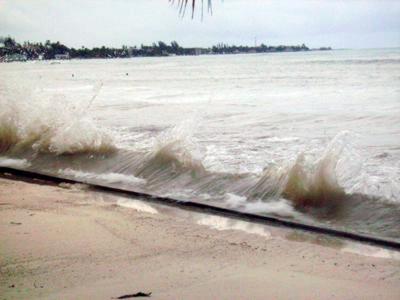 |
As Hurricane Dean churned and gained strength over the Caribbean Sea, large, rolling waves crashed on shore on La Isla Bonita.
|
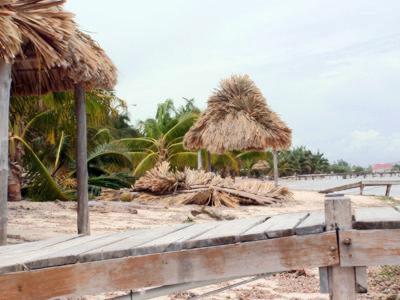 |
| Fallen trees, broken piers and plenty of debris dotted the shoreline of San Pedro.
|
Hurricane Dean left a trail of destruction as it surged across the Caribbean region early Wednesday morning. Toppling trees, power lines, flooding streets, houses, businesses and tearing roofs off many homes, Dean bore down on the Yucatan Peninsula where the Category Five storm made landfall. As the first major Atlantic Hurricane to wreak havoc across the Caribbean region this season, all eyes were on Monster Dean as it made its way closer to home. And, while the Northern Districts of Belize got its fair share of destruction with intense winds, torrential rains and floods, the country could breathe a sigh of relief that the storm did not cause much devastation but left people anticipating a very active hurricane season.
Dean entered the eastern Caribbean on Friday, August 17th, bringing torrential downpours and intense winds to the islands of St. Lucia, Martinique, Dominica, and Guadalupe. Dean trampled the Caribbean Isles triggering landslides, lifting roofs off houses, knocking out power lines and destroying banana and sugar cane plantations. Over the weekend, the steadily intensifying hurricane hit Southern Haiti, as well as the Southern coast of Jamaica, damaging rooftops and flooding streets as it tore its way through the Caribbean.
As Dean made its way to Belize’s coastline, the National Emergency Management Organization (NEMO), as well as the San Pedro Emergency Committee (SPEC) held meetings in Belmopan assessing the situation. Voluntary evacuations were made and in San Pedro business continued as usual.
On Sunday, August 19th, NEMO advised the public that effective 3:00 p.m. a Hurricane Watch was issued from Belize City to Corozal, while a Tropical Storm Watch was issued for the rest of the country. Belize was now in Phase Red 1. On Monday, August 20th, Hurricane shelters in the Corozal, Orange Walk and Belize Districts were officially opened.
On Monday, Hurricane Dean, already a Category 5 storm began lashing Mexico’s Caribbean coast, with winds and rain that hit beach resorts. Seas churned as the storm came closer, which had already left a trail of destruction and killed 11 people so far on its rampage through the Caribbean. Dean had home owners and businesses boarding up windows along the East Coast of the Yucatan Peninsula, a strip of beach resorts with white sands and turquoise seas that is yet to fully recover from the devastation of Hurricane Wilma in 2005.
A hurricane warning was in effect from Cancun all the way south through Belize, as well as parts of the Yucatan’s Western coast. In Belize, the government evacuated Caye Caulker and Ambergris Caye, both major parts of Belize’s tourism industry and urged people to leave low-lying areas. Government ordered a dusk-to-dawn curfew from Belize City to the Mexican border. Authorities took preparedness measures evacuating Belize City’s three hospitals and were moving high-risk patients inland to the nation’s capital of Belmopan, founded after 1961’s Hurricane Hattie devastated Belize City. Mayor Zenaida Moya urged residents to leave Belize City, saying they do not have shelters strong enough to withstand a storm of Dean’s size.
Hurricane Dean crashed into the Caribbean coast of Mexico on Tuesday morning as a roaring Category 5 hurricane, the most intense Atlantic storm to make landfall in two decades. The eye of the storm made landfall near Majahual, a port popular with cruise liners and about 40 miles east-northeast of Chetumal and the Belize border, according to the U.S. National Hurricane Center.
The sea around the tourist island of Cozumel, normally bustling with yachts, diving boats and cruise ships, was ominously free of vessels as the waves became choppy. Powerful winds strong enough to blow rooftops, uproot trees and heavy rains were experienced in the northern parts of Belize. As Belize braced for the storm to move south, residents took full precautions to shutter up all doors and windows.
“Absolutely this is one of the most dangerous and biggest hurricanes we have had so far,” said Robert Leslie, Cabinet Secretary of the Belizean Government. Trees fell and debris flew through the air in Corozal on Belize’s northern border with Mexico as well as on the cayes. The area of Corozal in northern Belize had been bracing for the full brunt of hurricane conditions, but received substantial winds that left several people homeless and/or in broken homes. Rene Villanueva of Love FM in Belize reported that over 10,000 people had been evacuated from areas closest to the storm’s centre.
San Pedro’s very own, The Reef Radio, continued with their broadcasting throughout Dean keeping everyone informed of the conditions in San Pedro. It is reported that over 9,000 people evacuated the island. During the storm, callers to Belize’s Love FM living close to the eye of the storm said roofs were flying off buildings as Dean passed through. The station was defying the weather with a rolling call-in programme passing on public safety information and messages to listeners’ loved ones. During the storm, electricity and water was out, as residents huddled in their homes while the wind moaned through the darkened streets. Tin roofing ripped from houses clunked hollowly as it bounced in the wind whistling through San Pedro Town. Listeners remained close to their computers as they listened live via the stations website. SPEC gave their updated statements through Reef Radio’s airwaves and kept everyone informed.
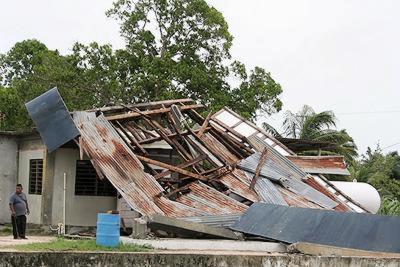 |
The Corozal and Orange Walk Districts received the most property damage. Industries in these areas also suffered immensely.
|
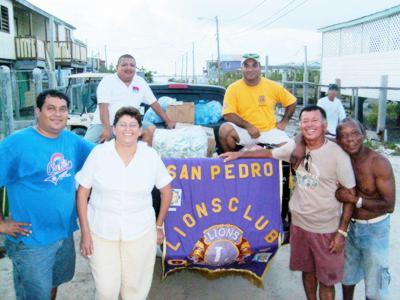 |
| With Dean creating destruction on our Northern towns and villages, many have joined in the humanitarian efforts to bring relief to those in need. The San Pedro Lions Club and the San Pedro Town Council joined hands and efforts to collect as much non-perishable goods and water as they could. A door-to-door drive was initiated and water, canned goods, rice, flour and many other items were sent to Corozal on Friday. However, much more help is needed and monetary donations are welcome. Kindly send them to Atlantic Bank Limited Account Number for the Lions Club 100030618.
|
Picking up the pieces
On August 21st, Prime Minister Said Musa declared the country in the Green Phase and government proceeded to have officials assess the full effects of the hurricane. With the exception of the Northern Corozal district, early estimates and initial hotel reports indicate very minimal damage to areas such as San Pedro and Caye Caulker. There was no damage sustained in Belize City or to the Western and Southern parts of Belize. Hotels and businesses in these areas are open and operational.
As reports indicate, fruit crops were destroyed; that is, mangoes, avocado, coconut, cornfields blown down and sugarcane fields water-logged and the papaya plantations completely wiped out. Trees were blown down in many areas. At this point there seems to be no extensive flooding. Corozal residents are now picking up the pieces of their homes and starting anew to recover from the hit.
In San Pedro, residents of the San Pedrito Area, and other low laying areas received rains that flooded houses and structures around town. The shoreline around the island is covered with debris and fallen uprooted trees. Some residents/visitors were unfazed before and after the storm. Some three hundred people were reported to have stayed behind; rescue efforts were conducted throughout the island for people in areas that were considered vulnerable and unsafe. Some residents refused to leave their homes whilst others were taken to the San Pedro Roman Catholic School hurricane shelter.
Community efforts continue in an effort to raise funds for storm victims who were affected by the storm. Back in Ambergris Caye, since Dean’s hit on Monday, clean up efforts have begun and the island will soon be cleared of debris. The land we know as “La Isla Bonita” is ready with open arms and already greeting their visitors. Welcome to Belize!
Dean made history
Hurricane Dean is the fourth named storm, first hurricane, and first major hurricane of the 2007 Atlantic hurricane season. It is the most intense tropical cyclone in the Atlantic basin since Hurricane Wilma of 2005, the ninth most intense Atlantic hurricane ever recorded and the third most intense land falling Atlantic hurricane.
Dean was a top-scale Category 5 storm at landfall on Tuesday on Mexico’s Yucatan Peninsula. Its maximum sustained winds were 165 mph and gusts reached 200 mph. Just before landfall, a Global Positioning System device dropped from a hurricane hunter aircraft found it had a central pressure of 906 millibars, forecasters said.
The only other storms that hit land with a lower pressure were the 1935 Labor Day hurricane that hit the Florida Keys and Hurricane Gilbert, which hit Cancun, Mexico, in 1988, forecasters said.
Gilbert caused more than 300 deaths in Latin America and the Caribbean. The 1935 hurricane was responsible for more than 400 deaths in the Keys, primarily among World War I veterans working on a highway connecting the island chain to the mainland.
Only three Category 5 storms have been known to hit land: the 1935 Labor Day hurricane, Hurricane Camille in 1969 and Hurricane Andrew in 1992. Andrew had top sustained winds of 165 mph at landfall. Andrew was the second-most expensive hurricane in U.S. history, after Hurricane Katrina.
Hurricane Wilma is the most intense Atlantic hurricane ever recorded in terms of pressure: It was at 882 millibars when it was in the Caribbean before it weakened ahead of landfall in the Yucatan.
The lowest pressure ever recorded in a tropical cyclone was 870 millibars in Typhoon Tip in the northwest Pacific Ocean in 1979.
Witness Accounts
Loli Arzu
– Spent the hurricane at the Boca del Rio Area with her seven children, ages 17, 15, 14, 12, 8, 5, 3
At around 11:00 p.m. my children who were in the kitchen in bed asleep called me and I came to see … the water had already risen and reached our home. The whole street was completely flooded, at points up to five feet high. We went to the church next door to pass the rest of the storm. It was horrible, the wind was deafening. It was not as much rain as it was wind. There were about 20 people there and we came out around 7:00 a.m. We went to check things at our house and were lucky enough to not have had much damage.
Allan Lima Spent the hurricane at his family’s home in Corozal – Corozal had the worst of the hurricane, the wind started around 6:00 p.m. on Monday evening, then it came stronger and stronger, around mid night, we got lots of rain! The wind was VERY strong,; we kept opening the back door to see the trees swinging from side to side. LOTS of trees came down, wires, zinc roofs – LOTS of them! Lots of houses were affected.
Charlene Estrada – San Pedro
Spent the hurricane on the island with her two boys, 2 and 10 – We stayed at our house for as long as we could. By 11:00 p.m. the street had already began getting flooded so we had to move. It was not nice with the wind and big rain. When we returned home we found all our stuff wet and as the water went down, the smell was horrible. Smelled like the raw sewage from the septic tanks had filled out our house. We lost almost everything.
Laura Pacheco – Banyan Bay Villas The beaches got washed out and, like most places, our trees got uprooted. We did receive damage to our dock, as did many people but Rico’s and the rest of our Villas have been up and running since Wednesday. Only one family stayed at Banyan Bay during Dean and they were just fine. San Pedro is getting back on its feet and ready to go.
Jorge Aldana – Centaur Cable Network – Corozal Town We started getting gusts of winds from 7:00 p.m. and it kept increasing in intensity every half and hour or so. By 11:30 to 12 midnight we lost electricity … the wind picked up more aggressively until 2:00 a.m. when we began experiencing Tropical Storm winds and up to 75 mph … the hurricane winds proceeded until 6:00 a.m. Only about 180 people made use of the hurricane shelters … others spent the night with family members or friends … a bit more than a half of the population evacuated … Corozal Town received severe damage as did the rural areas of Xaibe, Chan Chen, Consejo, who were severely battered. More than a half of the villages were destroyed as much as up to 75% … over 35,000 acres of sugar cane was destroyed while the Papaya Industry received 100% total damage. Thankfully there were no casualties, no missing person reports and no major injuries. Help has begun to arrive hope is alive.
James Janmohammed – National Emergency Management Organization (NEMO) Every experience helps a lot and what we got from this one, and it really scares me, is the fact that some people knew their homes could not withstand the storm and yet they chose to stay. We had to move them in the middle of the night and some still refused to move … it was not through lack of trying they would not move still. This is not smart. As far as the evacuation and hurricane preparedness plan it was sensibly done. Some fail to realize the severity of the situation. Had Dean moved 54 miles south we would have had a disaster and San Pedro would have been worse than Keith. For those that believe that NEMO overreacted, please come to see me at my house. I can not afford to listen to these people because I have a community to help. I extend a big kudos for their great help to the coast guards, the military and the police. We should be proud of the work that they did and was done.
Elsa Paz – Mayor, San Pedro Town I think San Pedro was okay. We didn’t have any kind of big damages, none of the houses were down and as you can notice, if you have been around, there were loose zincs from the roofs. So we are okay. It is more like a cleanup campaign that we have to have and I believe that by the end of this weekend, we will have San Pedro clean again.

|





